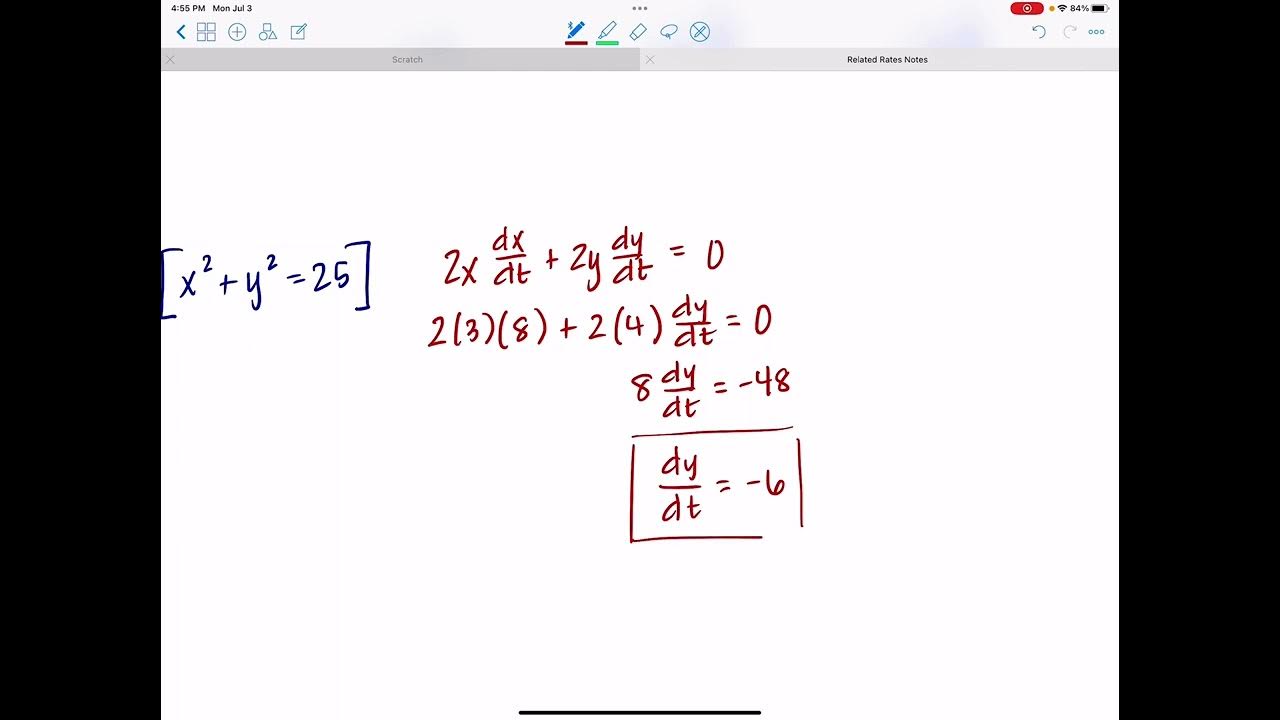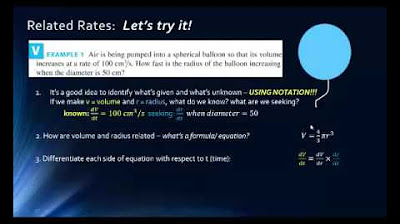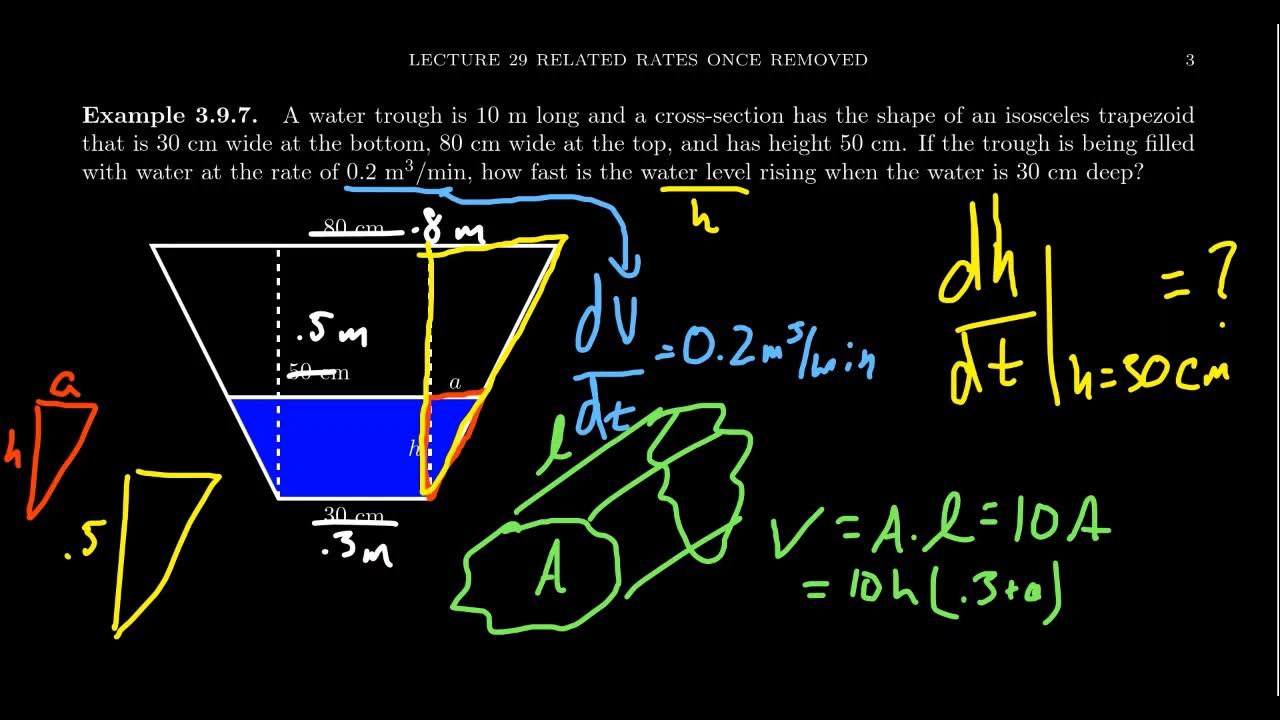Lesson 7 - Related Rates Problems in Calculus (Calculus 1 Tutor)
TLDRIn this calculus lesson, the focus is on related rates, a challenging concept involving the application of derivatives to word problems. The instructor emphasizes the importance of understanding how to find rates of change, as exemplified by a problem involving a melting snowball. The key is to identify the given rate of volume decrease and use it to find the rate at which the diameter decreases when it equals 10 centimeters. The lesson aims to demystify the process by breaking it down methodically, encouraging students to practice and recognize patterns in similar problems.
Takeaways
- 📚 The course section focuses on related rates, a challenging topic in calculus involving word problems.
- 🤔 Related rates problems can be intimidating due to the combination of calculus and word problem-solving.
- 🧠 The concept revolves around understanding rates and using derivatives, which represent slopes or rates of change.
- 📉 The problem provided involves a melting snowball, with the volume decreasing at a rate of one cubic centimeter per minute.
- 🔍 The task is to find the rate at which the diameter of the snowball is decreasing when the diameter is 10 centimeters.
- 📌 Key terms to focus on in related rate problems include 'rate' and 'at what rate', which guide you towards finding derivatives.
- 👓 When solving, you must identify the given derivative (rate of volume change) and the desired derivative (rate of diameter change).
- 🔢 The problem requires using the given information about the snowball to set up and solve for the unknown rate of diameter change.
- 💡 It's important to recognize that related rate problems may seem complex, but with practice, similarities in problems will emerge.
- 📈 The process involves methodically writing down what is known, focusing on the key variables, and applying calculus concepts to find the solution.
Q & A
What is the main topic being discussed in the transcript?
-The main topic being discussed is related rates, a concept in calculus that involves solving word problems involving rates and derivatives.
Why can related rates be a challenging topic for many students?
-Related rates can be challenging because they involve solving word problems that require understanding and applying calculus concepts, particularly derivatives, in a real-world context.
What is the significance of the word 'rate' in the context of related rates?
-In the context of related rates, 'rate' refers to the derivative, which is the rate of change of one quantity with respect to another, such as the rate of change of volume with respect to time.
How does the problem of a melting snowball relate to related rates?
-The melting snowball problem relates to related rates by providing a scenario where the volume of the snowball decreases at a certain rate, and the task is to find the rate at which the diameter decreases at a specific time.
What is the given rate of volume decrease for the snowball in the problem?
-The given rate of volume decrease for the snowball is one cubic centimeter per minute.
What specific measurement are we asked to find the rate of decrease for in the snowball problem?
-We are asked to find the rate at which the diameter of the snowball is decreasing when the diameter is equal to 10 centimeters.
What is the strategy for solving related rate problems?
-The strategy for solving related rate problems involves identifying the given rates, understanding the relationships between the quantities involved, and applying calculus to find the unknown rates.
Why is it important to focus on certain keywords when reading related rate problems?
-Focusing on certain keywords, such as 'rate', helps to identify the parts of the problem that are directly related to derivatives and the rate of change, which are crucial for solving the problem.
What happens when the snowball's diameter equals 10 centimeters in the problem?
-When the snowball's diameter equals 10 centimeters, we are asked to determine how fast the diameter is changing at that specific moment.
How can working through related rate problems help a student understand the concept better?
-Working through related rate problems helps a student understand the concept better by allowing them to see the practical application of derivatives and the rate of change in various scenarios, which reinforces their understanding of the underlying calculus concepts.
Outlines
📚 Introduction to Related Rates in Calculus
This paragraph introduces the concept of related rates, a challenging topic in the early stages of calculus. The speaker explains that related rates involve taking derivatives and solving word problems that describe rates of change. The paragraph emphasizes the difficulty many students face with this section, especially if they are not comfortable with word problems. The speaker reassures the audience that by working through the problems, they will begin to understand the process and recognize patterns. The paragraph sets the stage for a problem-solving session, where the speaker will guide the audience through a specific problem involving a melting snowball.
Mindmap
Keywords
💡Related Rates
💡Derivatives
💡Word Problems
💡Rate of Change
💡Snowball
💡Volume
💡Diameter
💡Strategy
💡Solving Problems
💡Contextual Understanding
Highlights
The topic of related rates is introduced as one of the tougher problems in calculus.
Related rates involve word problems that combine calculus with real-world scenarios.
Derivatives, which represent slopes or rates of change, are key to solving related rate problems.
The course aims to help students overcome their fear of word problems in calculus.
A snowball melting example is used to illustrate a typical related rates problem.
The volume of the snowball decreases at a rate of one cubic centimeter per minute.
The problem asks for the rate at which the diameter of the snowball is decreasing when it has a diameter of 10 centimeters.
Key words such as 'rate' are crucial in understanding the problem's requirements.
The problem is about finding the derivative of the diameter with respect to time at a specific point.
The challenge lies in handling the numbers and terminology within the word problem context.
The importance of practice is emphasized to gain comfort with related rate problems.
The problem-solving process involves identifying given information and applying it to find the unknown.
The transcript provides a step-by-step approach to tackle related rate problems.
Understanding the concept of derivatives as rates of change is fundamental to solving the problem.
The example problem demonstrates the application of calculus in a physical scenario.
The goal is to help students see the similarities in related rate problems to aid their understanding.
The transcript encourages students to work through problems to eventually grasp the concepts.
Transcripts
5.0 / 5 (0 votes)
Thanks for rating:





